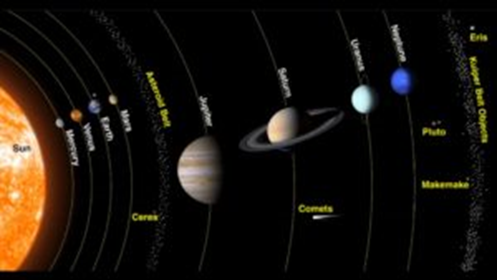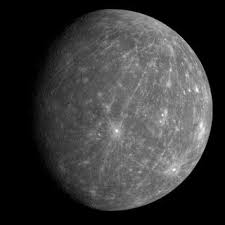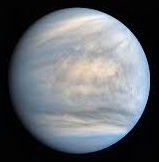Science > Physics > Astronomical Physics > Our Solar System

The Sun, the eight planets that revolve around it, their satellites, asteroids, and comets all together form our solar system. In the universe, there may be many stars with their own solar system. The sun is the centre of our solar system. All the objects revolve around the sun due to gravitational force. Mercury (Budha), Venus (Shukra), Earth (Prithvi), Mars (Mangal), Jupiter (Guru or Brihaspati), Saturn (Shani), Uranus and Neptune are the eight planets in order of their distances from the sun that revolve around the sun each in a different orbit. We cannot draw the solar system to scale because the planets are very big and their distances from the sun are thousands of kilometre. If we take the sun as a ball of diameter 10 cm then the earth would be at a distance of 11 m away from the centre of the ball on paper.
The motion of the planet around the sun is called the revolution of the planet. The time taken by a planet to go once around the sun is called the period of revolution of the planet. The motion of the planet around its axis is called the rotation of the planet. The time taken by a planet to complete one rotation about its axis is called the period of rotation of the planet. Planets revolve around the sun in the definite path, which is called the orbit of the planet. The radii of orbits of different planets are different. Hence these orbits never intersect each other. Hence there is no possibility of collision of planets.
Up to 2006, Pluto was considered to be the ninth and the farthest planet of the solar system. However, the revolution of Pluto does not meet the criteria used by the Astronomical Society to define a planet’s revolution orbit. Hence Pluto is not considered to be a planet anymore. Instead, Pluto and all other heavenly bodies like it are now classified as Dwarf planet. A dwarf planet is a small planet who does not meet the criteria used by the Astronomical Society to define a planet’s revolution orbit. In our solar system, there are three dwarf planets Ceres (between Mars and Jupiter), Pluto and Eris (Orbit beyond Neptune). Earlier Ceres was considered to be an asteroid.
Every planet has a different period of revolution. The greater the distance of a planet from the sun, the greater is its period of revolution. The period of revolution of Mercury is just 88 days, while that of Neptune is as long as 146 years. Planets rotate around their axes and simultaneously revolve around the Sun.
Small heavenly bodies are seen to revolve around some of the planets. They are called the planet’s satellites or moons. The Earth has one moon. Mars has two moons. Saturn has more than 60 moons. The satellite is a heavenly body revolving around a planet and not around the star. Hence the Earth around the sun under the action of gravitational force we cannot call the Earth as the satellite of the Sun.
Planets change their positions with respect to the star. Planets don’t have their own light of their own. They reflect the light of the star falling on them. Planets are much nearer and hence appear as a disc. Their disc positions do not appear to vibrate due to air currents etc. in the atmosphere and hence planets do not twinkle.
The planets whose orbits are inside the Earth’s orbit are called inferior planets. Mercury and Venus are inferior planets. The planets whose orbits are outside the Earth’s orbit are called superior planets. Mars, Jupiter, Saturn, Uranus, Neptune are superior planets. Mercury, Venus, Earth and Mars are very much nearer to the Sun than the other planets. They are called inner planets. Inner planets have few moons. The planets outside the orbit of Mars namely Jupiter, Saturn, Uranus, Neptune are much farther of than inner planets from the sun. They are called outer planets. Outer planets have a large number of moons. They show ring system around them. Inner planets are called terrestrial planets because their structure is rocky similar to that of the Earth. Outer planets are called Jovian planets because their structure is gaseous similar to that of Jupiter.
Planets:
Mercury (Budha):

It is the smallest planet in our solar system. It is the nearest planet to the sun. It is hidden in the glare of the sun. Hence we cannot see it easily. It can be seen at the sunrise or sunset on the horizon. It does not have any moon. Its gravitational force is so weak that it is not capable of holding the atmosphere. Thus the atmosphere on Mercury is thin. During day Mercury is very hot (700 K) while due to the absence of atmosphere the heat is lost very fast, hence nights are very cold (90 K).
Venus (Shukra):

It is the nearest planet to the Earth. It looks bright early in the morning (1 to 3 hours before sunrise) in the eastern sky and late in the evening(1 to 3 hours after sunset) in the western sky. Hence it is called the Morning star or the Evening star. Actually, it is not a star. Venus is the brightest planet of all or it is the third brightest celestial object after the Sun and the Moon. We cannot see Venus very high in the sky. It does not have any moon. Venus has a special feature. It rotates about its axis from the East to the West. Thus for Venus, the Sun rises in the west and sets in the East. It shows phases like our moon. Its size is almost the same as that of the Earth. It has a high percentage of carbon dioxide in its atmosphere which traps heat due to the greenhouse effect.
The Earth (Prithvi):

The factors or environmental conditions for life such as the right temperature, water, air, atmosphere, protection from ultraviolet rays due to the ozone layer, etc. are only on the Earth of all the planets of our solar system. Hence the Earth has the living world. The axis around which the Earth rotates is not perpendicular to its orbit but slightly inclined to it. Because of this, the Earth has seasons like summer and winter. The Earth has only one moon. From space, the Earth appears to be blue-green due to the reflection of light from water and landmass on its surface. The Erath takes 365.25 days to complete one revolution around the sun, while it takes 24 hours or one day to rotate about its axis.
Mars (Mangal):

The soil of Mars is rich in iron hence the planet appears red. Hence it is also called as red planet. It is about half the size of the Earth. The mass has a very thin atmosphere having traces of carbon dioxide, nitrogen, hydrogen, and oxygen. It has water on its surface. It is a cold planet. It has two moons namely Deimos and Phobos.
Jupiter (Guru or Brihaspati):

It is the largest planet in the solar system. It is big enough to hold 1397 Earths within itself but its mass is only 318 times that of the Earth. Jupiter rotates very fast about its axis. It takes 10 hours to complete one rotation about its axis. It has 63 satellites but we can see four of them by telescope. It has a faint ring around it. Jupiter is a gaseous planet. It has no solid surface.
Saturn (Shani):

After Jupiter the next planet is Saturn. It has rings of ice and dust around it. These rings can be seen using a telescope. Its density is less than water. If there were large enough ocean of water this huge planet would float in it. It appears yellowish in colour. It has a large number (61) of satellites. Saturn is a gaseous planet.
Uranus (Arun) and Neptune (Varun):
They can not be seen without the help of the telescope because they are the outermost planets. Like Venus Uranus to rotates from the East to the West. Besides its axis of rotation is inclined at a very high angle. Hence it appears to roll along its orbital path. Uranus is a gaseous planet and bigger than the Earth and appears greenish. It has 29 moons. Neptune is a gaseous planet and has 13 moons.
Other Members of Solar System
Asteroids:

There is a large gap between the orbits of Mars and Jupiter. This gap is occupied by a large number of small bodies that revolve around the sun. These bodies are called asteroids. Asteroids can only be seen through a large telescope. They are small lumps of rocks orbiting around the sun between Jupiter and Mars. They are considered to be remains of a much larger planet which broke up due to the gravitational effect of Jupiter. The size of an asteroid may vary from a kilometre to a few hundred kilometres. There about 1,00,000 asteroids. They are bodies of a solar system that have failed to assemble into a planet.
Comets:

Comets revolve around the sun in highly elliptical or parabolic orbits. Usually, they have very long periods of revolution. A comet consists of a brilliant sphere called the head and a long tail. Thus the luminous end of the comet pointing towards the sun is called the head of the comet. A comet becomes visible when it approaches the Sun because Sun’s rays make the gas glow. Since the tail of a comet is caused due to light radiations from the sun, hence it always points away from the Sun. As the comet approaches the sun its tail becomes longer.
The comet which appears after a regular interval of time is called a periodic comet. e.g. Halley’s Comet. Halley’s comet is seen once in 76 years. Last it was seen in 1986. Now it will be seen in the year 2062. Some comets approach the Sun only once and move far away from the Sun, not to return. When the Earth passes through the tail of a comet. Meteor showers are seen. This is a very attractive sight. Innumerable meteors are seen in the sky.
Superstitions about comets:
Some people think that comets are messengers of disasters, such as wars, epidemics and floods. But these are all myths and superstitions. The appearance of a comet is a natural astronomical phenomenon. We have no reason to be afraid of it. Comets are massive celestial bodies composed of different gases and as the comet approaches the Sun, it begins to absorb solar energy. Hence the matter in the comet starts vapourising and spreads behind. Thus the tail of a comet is on the opposite side to that of the Sun. the tail of comet extends millions of kilometres.
Meteors:

When some small celestial body moving around the Sun (meteorite) comes near to the Earth, the Earth pulls the body towards itself. That body falls through the Earth’s atmosphere at great speed. As it falls, the friction with the constituents of the atmosphere causes its temperature to rise and it begins to glow. This is called a meteor or shooting star or falling star. A meteor traces a bright line in the sky while falling. It evaporates very quickly and hence the bright streak lasts for a very short time. Hence it does not cause any harm on the Earth.
Some meteors are very large and so they can reach Earth’s surface before they evaporate completely. Such body reaching the Earth is called a meteorite. Meteorites help scientists in the investigation of nature of the material from which the solar system is made up of. When the Earth passes through the tail of a comet swarms of meteors are seen. These are known as meteor showers. Some meteor showers occur at regular intervals each year. When large objects called asteroids break into small pieces, they form meteorites.
The number of meteors striking the moon’s surface is quite large because the moon has no atmosphere to burn the falling meteors by frictional heat. Hence these meteors do not get vapourised and they strike the moon’s surface and hence many craters are formed on the surface of the moon. On the other hand, the Earth has an atmosphere containing air, hence due to friction with air, the meteors generally vapourises and burnt up completely.
Distinguishing between star and shooting star:
|
Star |
Shooting Star |
|
A star is made up of hot gases like hydrogen. |
A shooting star is made up of rock and metal. |
|
A star is self-luminous |
A shooting star has no light of its own. |
|
A star does not get destroyed due to friction. |
A shooting star burns due to the heat of friction when entering the atmosphere of the Earth. |
|
A star is very big in size. |
A shooting star is very small in size. |